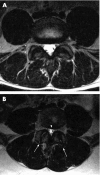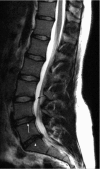MRI findings in the lumbar spines of asymptomatic, adolescent, elite tennis players
- PMID: 17640926
- PMCID: PMC2465278
- DOI: 10.1136/bjsm.2007.037747
MRI findings in the lumbar spines of asymptomatic, adolescent, elite tennis players
Abstract
Objective: To describe magnetic resonance imaging (MRI) findings in the lumbar spine in asymptomatic elite adolescent tennis players, to serve as the baseline for a future prospective longitudinal cohort study.
Design: Observational study.
Setting: Institutional, national tennis centre.
Participants: 33 asymptomatic elite adolescent tennis players, mean (SD) age, 17.3 (1.7) years (18 male, 15 female).
Methods: Sagittal T1, T2, STIR, and axial T2 weighted MRI images were reviewed for the presence of abnormalities by two radiologists in consensus. Abnormalities included disc degeneration, disc herniation, pars lesions (fracture or stress reaction), and facet joint arthropathy.
Results: Five players (15.2%) had a normal MRI examination and 28 (84.8%) had an abnormal examination. Nine players showed pars lesions (10 lesions; one at two levels) predominately at the L5 level (9/10, L5; 1/10, L4). Three of the 10 lesions were complete fractures; two showed grade 1 and one grade 2 spondylolisthesis, both of which resulted in moderate narrowing of the L5 exit foramen. There were two acute and five chronic stress reactions of the pars. Twenty three patients showed signs of early facet arthropathy occurring at L5/S1 (15/29 joints) and L4/5 (12/29 joints). These were classified as mild degeneration (20/29) and moderate degeneration (9/29), with 20/29 showing sclerosis and 24/29 showing hypertrophy of the facet joint. Synovial cysts were identified in 14 of the 29 joints. Thirteen players showed disc desiccation and disc bulging (mild in 13; moderate in two) most often at L4/5 and L5/S1 levels (12 of 15 discs).
Conclusions: Abnormalities were frequent, predominately in the lower lumbar spine, almost exclusively at L4/5 and L5/S1 levels. Pars injuries and facet joint arthroses were relatively common.
Conflict of interest statement
Conflict of interest: None declared.
Similar articles
-
Lumbar spine abnormalities and facet joint angles in asymptomatic elite junior tennis players.Sports Med Open. 2020 Nov 25;6(1):57. doi: 10.1186/s40798-020-00285-4. Sports Med Open. 2020. PMID: 33237502 Free PMC article.
-
MRI findings in the lumbar spines of asymptomatic elite junior tennis players.Skeletal Radiol. 2014 Jul;43(7):925-32. doi: 10.1007/s00256-014-1862-1. Epub 2014 Apr 2. Skeletal Radiol. 2014. PMID: 24691895
-
The significance of increased fluid signal on magnetic resonance imaging in lumbar facets in relationship to degenerative spondylolisthesis.Spine (Phila Pa 1976). 2007 Aug 1;32(17):1883-7. doi: 10.1097/BRS.0b013e318113271a. Spine (Phila Pa 1976). 2007. PMID: 17762297
-
Evaluation and Treatment of Lumbar Facet Cysts.J Am Acad Orthop Surg. 2016 Dec;24(12):829-842. doi: 10.5435/JAAOS-D-14-00461. J Am Acad Orthop Surg. 2016. PMID: 27792054 Review.
-
Lumbar Facet Tropism: A Comprehensive Review.World Neurosurg. 2017 Jun;102:91-96. doi: 10.1016/j.wneu.2017.02.114. Epub 2017 Mar 6. World Neurosurg. 2017. PMID: 28279769 Review.
Cited by
-
Temporal Evolution of Disc in Young Patients with Low Back Pain and Stress Reaction in Lumbar Vertebrae.AJNR Am J Neuroradiol. 2017 Aug;38(8):1647-1652. doi: 10.3174/ajnr.A5237. Epub 2017 Jun 1. AJNR Am J Neuroradiol. 2017. PMID: 28572152 Free PMC article.
-
Lumbar spine MRI findings in asymptomatic elite male academy footballers: a case series.BMC Sports Sci Med Rehabil. 2022 Oct 24;14(1):184. doi: 10.1186/s13102-022-00576-1. BMC Sports Sci Med Rehabil. 2022. PMID: 36280886 Free PMC article.
-
The Incidence of Pars Interarticularis Defects in Athletes.Global Spine J. 2020 Feb;10(1):89-101. doi: 10.1177/2192568218823695. Epub 2019 Feb 24. Global Spine J. 2020. PMID: 32002353 Free PMC article. Review.
-
Sagittal spinal morphology in highly trained adolescent tennis players.J Sports Sci Med. 2013 Sep 1;12(3):588-93. eCollection 2013. J Sports Sci Med. 2013. PMID: 24149169 Free PMC article.
-
Lumbar spine abnormalities and facet joint angles in asymptomatic elite junior tennis players.Sports Med Open. 2020 Nov 25;6(1):57. doi: 10.1186/s40798-020-00285-4. Sports Med Open. 2020. PMID: 33237502 Free PMC article.
References
-
- Hogan K A, Gross R H. Overuse injuries in pediatric athletes. Orthop Clin North Am 200334405–415. - PubMed
-
- Adirim T A, Cheng T L. Overview of injuries in the young athlete. Sports Med 20033375–81. - PubMed
-
- Hawkins D, Metheny J. Overuse injuries in youth sports: biomechanical considerations. Med Sci Sports Exerc 2001331701–1707. - PubMed
Publication types
MeSH terms
LinkOut - more resources
Full Text Sources
Medical
Miscellaneous




